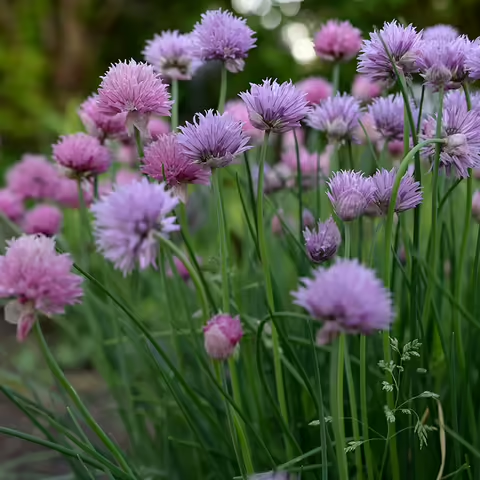Chives
Allium schoenoprasum
Chives belong to the same family as onion, leeks and garlic. They are a hardy, drought-tolerant perennial growing to about 10-12 inches tall. They grow in clumps from underground bulbs and produce round, hollow leaves that are much finer than onion. In mid-summer, they produce round, pink flowers similar in appearance to clover.
Growing: Perennial
Chives prefer a full sun location and are tolerant of a wide variety of soils but will grow best in soils that are high in organic matter. Chives are most commonly propagated by dividing the clumps in early spring. Clumps should contain about 4-6 bulbs. They can also be grown from seed sown in spring. Seed may be slow to germinate and take 4-6 weeks to produce transplants. Plants grown from seed will produce variations in leaf texture and size. To keep plantings vigorous and from becoming overcrowded, divide plants every 2-3 years. Plants that are harvested frequently benefit from supplemental fertilizer during the season. Chives can self-sow and overtake a garden unless flowers are removed before they fade. Chives also make attractive edging in the perennial border and flowers can be cut for arrangements.
Popular Varieties
- ‘Grolau’ Chives - This Swiss strain has been developed for indoor culture and greenhouse forcing. Extra strong flavor and thick, dark leaves. Less susceptible to becoming leggy.
- ‘Nelly’ Chives - Fine texture leaves, blue-green in color, uniform upright habit.
- ‘Profusion’® Chives - Prolific production of leaves and flowers. Flowers are sterile and don’t produce seeds. Good variety for pot culture.
- ‘Staro’ Chives – Extra thick dark leaves.
- Garlic Chives (Allium tuberosum) – Also called Chinese Chives. Similar in appearance to garden chives but leaves are flat and not round and flowers are white not pink. Growing to about 12-18 inches. Culture is the same as for garden chives. Distinct garlic flavor to the leaves. Excellent as an ornamental-edible border plant. Cultivar ‘Kobold’ is more compact and uniform.
Harvesting
Harvest chives throughout the season to prevent the leaves from becoming tough and to encourage formation of new bulblets. Cut leaves toward the base about one inch above the soil. Flowers can also be harvested for use as an edible garnish. Leaves are used fresh and can be dried but will discolor and quickly absorb moisture. Chives can also be frozen for later use.
Uses
Leaves can be used to flavor salads, dips, soups, stews, vinegars, cheese dishes sour cream and butter. Flavor is much milder and more subtle than other members of the onion family.
Indoor Culture
Chives are easily grown in pots placed in a sunny location. Use pots with good drainage and fill with a prepared soil mix. Water to maintain uniform soil moisture. To achieve the best looking potted chives, dig clumps from the garden after a freeze (December- January). Plants potted in the fall for indoor growing do not perform as well and tend to become “leggy."
